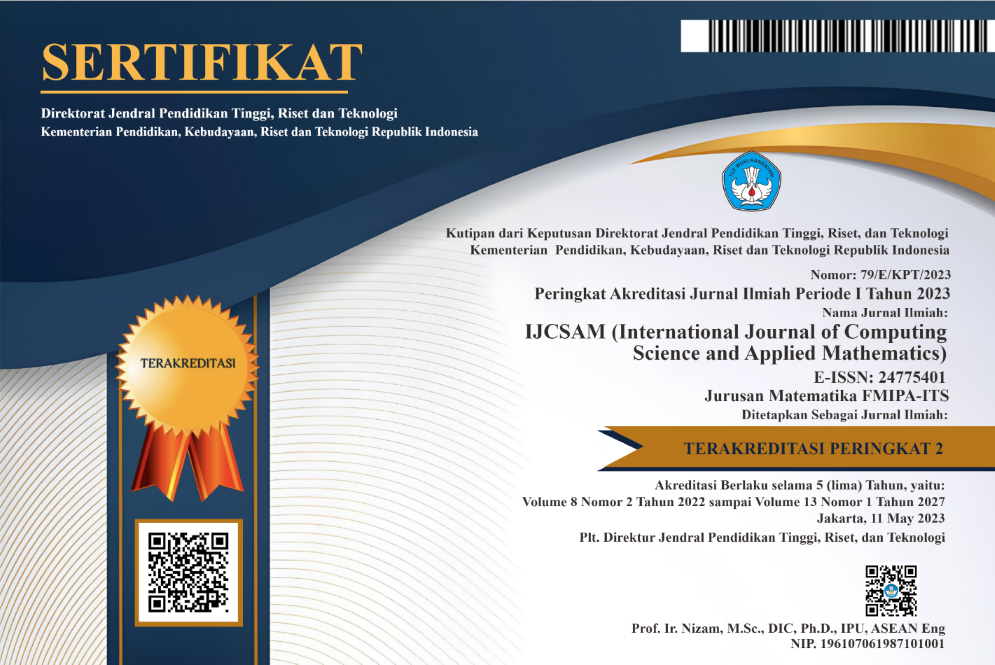Analyzing Factors Contributing to Gender Inequality in Indonesia using the Spatial Geographically Weighted Logistic Ordinal Regression Model
Abstract
Full Text:
PDFReferences
S. D. Judiasih, “Implementasi Kesetaraan Gender Dalam Beberapa Aspek Kehidupan Bermasyarakat Di Indonesia,” ACTA DIURNAL Jurnal Ilmu Hukum Kenotariatan, vol. 5, no. 2, Art. no. 2, Jun. 2022, doi: 10.23920/acta.v5i2.904.
A. Rahim, “Gender Dalam Perspektif Islam,” SOSIORELIGIUS: JURNAL ILMIAH SOSIOLOGI AGAMA, vol. 3, no. 1, Art. no. 1, Oct. 2018, doi: 10.24252/sosioreligius.v3i1.6372.
S. Ponthieux and D. Meurs, “Chapter 12 - Gender Inequality,” in Handbook of Income Distribution, A. B. Atkinson and F. Bourguignon, Eds., vol. 2. Elsevier, 2015, pp. 981–1146, doi: 10.1016/B978-0-444-59428-0.00013-8.
G. Valsecchi, V. Iacoviello, B. Jacques, I. Borinca, and J. M. F. Pichastor, “Men’s Gender Norms and Gender-Hierarchy-Legitimizing Ideologies: The Effect of Priming Traditional Masculinity Versus a Feminization of Men’s Norms,” Gender Issues, vol. 40, no. 1, pp. 465–480, 2023, doi: 10.1007/s12147-022-09308-8.
N. I. Fadila, C. S. Riyanto, I. M. C. Avisya, B. C. Irianti, and D. O. Radianto, “Kesetaraan Gender,” Humantech: Jurnal Ilmiah Multidisiplin Indonesia, vol. 2, no. 8, Art. no. 8, Jun. 2023.
V. Aprilia and M. Triani, “Analisis Pengaruh Ketimpangan Gender, Rasio Ketergantungan Dan Kesehatan Terhadap Kemiskinan Di Indonesia,” Jurnal Kajian Ekonomi dan Pembangunan, vol. 4, no. 3, Art. no. 3, Sep. 2022, doi: 10.24036/jkep.v4i3.13772.
BPS RI, “Indeks Ketimpangan Gender (IKG) 2022,” www.bps.go.id, 2023.
F. Razi, Rencana Strategis Kementerian Agama Tahun 2020-2024. Jakarta: Kementerian Agama Republik Indonesia, 2020.
Tim Kemen PPPA, Pembangunan Manusia Berbasis Gender. Jakarta: Kementerian Pemberdayaan Perempuan dan Perlindungan Anak Republik Indonesia, 2022. [Online]. Available: https://www.kemenpppa.go.id/
BPS, Kajian Penghitungan Indeks Ketimpangan Gender 2021. Jakarta: BPS Republik Indonesia, 2021.
Marsono, “Deteksi Spasial Pada Model Indeks Ketimpangan Gender Indonesia,” Buana Gender, vol. 6, no. 1, pp. 49–66, 2021.
TIM BPS RI, Kajian Penghitungan Indeks Ketimpangan Gender 2022. Jakarta: BPS-Statistics Indonesia, 2022. [Online]. Available: https://www.bps.go.id/publication/
S. Zuhdi, D. R. S. Saputro, and P. Widyaningsih, “Parameters Estimation of Geographically Weighted Ordinal Logistic Regression (GWOLR) Model,” J. Phys.: Conf. Ser., vol. 855, p. 012064, Jun. 2017, doi: 10.1088/1742-6596/855/1/012064.
R. Amalah, A. K. Jaya, and N. Sirajang, “Pemodelan Geographically Weighted Logistic Regression dengan Metode Ridge,” ESTIMASI: Journal of Statistics and Its Application, pp. 130–143, Aug. 2023, doi: 10.20956/ejsa.v4i2.12250.
R. N. Pradita, H. Yasin, and D. Safitri, “Pemodelan Faktor-Faktor Yang Mempengaruhi Indeks Pembangunan Manusia Kabupaten/Kota Di Jawa Timur Menggunakan Geographically Weighted Ordinal Logistic Regression,” Jurnal Gaussian, vol. 4, no. 3, Art. no. 3, Jul. 2015, doi: 10.14710/j.gauss.4.3.639-650.
V. F. Rochmah and V. Ratnasari, “Pemodelan Ketahanan Pangan di Jawa Timur Menggunakan Metode Geographically Weighted Ordinal Logistic Regression (GWOLR),” JSSITS, vol. 8, no. 2, pp. D397–D404, Feb. 2020, doi: 10.12962/j23373520.v8i2.47021.
M. Fathurahman, “Hypothesis testing of Geographically weighted bivariate logistic regression,” Journal of Physics: Conference Series, vol. 1417, pp. 1–8, 2019, doi: 10.1088/1742-6596/1417/1/012008.
A. R. Wardani, N. Gusriani, and D. A. Kusuma, “Pemetaan Zonasi Resiko Covid-19 Di Provinsi Jawa Barat Menggunakan Model Geographically Weighted Ordinal Logistic Regression (GWOLR),” Teorema: Teori dan Riset Matematika, vol. 7, no. 1, pp. 193-204, 2022.
M. Sari and P. Purhadi, “Pemodelan Indeks Pembangunan Manusia Provinsi Jawa Barat, Jawa Timur dan Jawa Tengah Tahun 2019 dengan Menggunakan Metode Regresi Logistik Ordinal,” Jurnal Gaussian, vol. 10, no. 1, Art. no. 1, Feb. 2021, doi: 10.14710/j.gauss.10.1.149-158.
V. N. Mishra, V. Kumar, R. Prasad, and M. Punia, “Geographically Weighted Method Integrated with Logistic Regression for Analyzing Spatially Varying Accuracy Measures of Remote Sensing Image Classification,” Journal of the Indian Society of Remote Sensing, vol. 49, no. 5, pp. 1189–1199, 2021, doi: 10.1007/s12524-020-01286-2.
G. Dong, T. Nakaya, and C. Brunsdon, “Geographically weighted regression models for ordinal categorical response variables: An application to geo-referenced life satisfaction data,” Computers, Environment and Urban Systems, vol. 70, pp. 35–42, Jul. 2018, doi: 10.1016/j.compenvurbsys.2018.01.012.
A. S. Fotheringham and T. M. Oshan, “Geographically weighted regression and multicollinearity: Dispelling the myth,” Journal of Geographical Systems, vol. 18, pp. 303–329, 2016.
Syinfi, Pemodelan Rata-rata Umur Kawin Pertama (UKP) Wanita Di Provinsi Jawa Timur Tahun 2012 Dengan Pendekatan Geographically Weighted Ordinal Logistic Regression (GWOLR), Thesis Program Statistika. Surabaya: ITS, 2015.
A. Fadliana, H. Pramoedyo, and R. Fitriani, “Implementation Of Locally Compensated Ridge-Geographically Weighte Regression Model In Spatial Data With Multicollinearity Problems(Case Study: Stunting among Children Aged under Five Years in East Nusa Tenggara Province),” MEDIA STATISTIKA, vol. 13, no. 2, pp. 125–135, Dec. 2020.
S. H. Hasanah, “Perbandingan Metode Klasifikasi Artificial Neural Network Backprogation dan Regresi Logistik (Studi Kasus: Bank Internasional Indonesia),” Jurnal Statistika dan Matematika, vol. 1, no. 1, Feb. 2019, doi: 10.32493/sm.v1i1.2372.
C. Anselin, Spatial Econometrics: Methods and Models. Netherlands: Kluwer Academic Publishers, 2013.
R. Aldila, M. Cahya, and K. Suryadi, “Spatio-Temporal Analysis for Detecting COVID-19 Spreading Pattern in Indonesia,” Journal of Mathematical and Fundamental Sciences, vol. 52, no. 3, pp. 250–268, Aug. 2020, doi: 10.5614/j.math.fund.sci.2020.52.3.5.
J. S. Long, Regression Models for Categorical and Limited Dependent Variables. California: SAGE Publications, Inc., 1997.
DOI: http://dx.doi.org/10.12962%2Fj24775401.v10i2.21942
Refbacks
- There are currently no refbacks.
View My Stats

International Journal of Computing Science and Applied Mathematics by Pusat Publikasi Ilmiah LPPM, Institut Teknologi Sepuluh Nopember is licensed under a Creative Commons Attribution-ShareAlike 4.0 International License.
Based on a work at https://iptek.its.ac.id/index.php/ijcsam.






